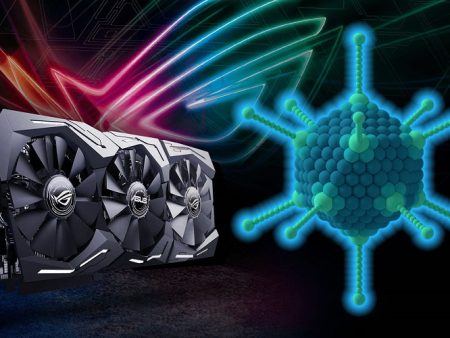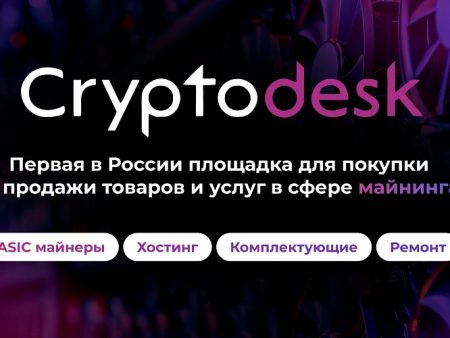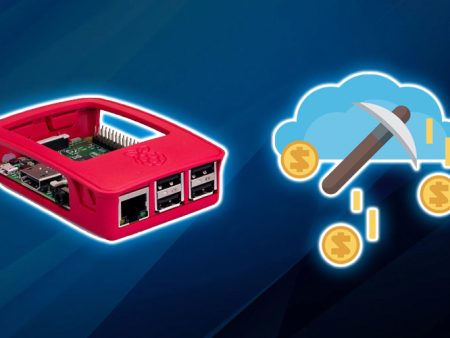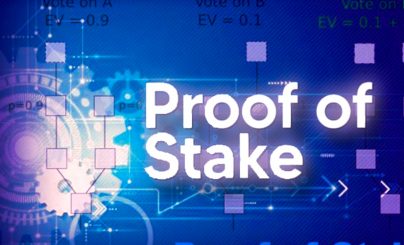
No 2022. gada 5. jūlija ir divas kriptovalūtas ieguves metodes - darba pierādījuma (Proof-of-Work, PoW) un paņemšanas pierādījuma (Proof-of-Stake, PoS) konsensa algoritmi. Šiem mehānismiem ir daudz atšķirību. Tomēr ar katru gadu arvien populārāka kļūst digitālo aktīvu ieguve, izmantojot Proof-of-Stake. Šis fakts ir izskaidrojams ar konsensa algoritma efektivitāti.
PoS ieguve ir digitālo aktīvu ieguve, veicot ieguldījumus. Šī pieeja ļauj blokķēdes dalībniekiem neizmantot jaudīgas iekārtas. Taču šī ieguves metode joprojām prasa lielus ieguldījumus.
Kas ir PoS ieguve
Kalnrūpniecību saskaņā ar Proof-of-Stake mehānismu sauc par likmju likšanu. Kalnrūpniecība ar šo metodi ietver verifikācijas mezglu izveidi kriptovalūtu tīklos. Tos sauc par validatoriem. Šie mezgli apstrādā darījumus un paraksta digitālo ķēžu blokus. Pretī validatori saņem atlīdzību no tīkliem.
Mezgla palaišana parasti ir dārgs process. Piemēram, lai kļūtu par Ethereum 2.0 blokķēdes validatoru, ir nepieciešams bloķēt 32 ETH - $35,800 pēc 2022. gada 5. jūlija kursa. Tomēr ir arī lētāki tīkli.
Galvenās iezīmes
PoS ieguvei ir nepieciešams iesaldēt interesējošo tīklu monētas kriptovalūtu makos vai attiecīgo ķēžu viedos līgumus. No 2022. gada 5. jūlija ir daudz koku likšanas pūlu. Tos veido validatori - mezgli, ko palaiduši lieli investori vai populāras kriptovalūtu platformas. Šie pūli ļauj klientiem piedalīties stekeingā ar minimālām investīcijām - no $1 vai pat mazāk.
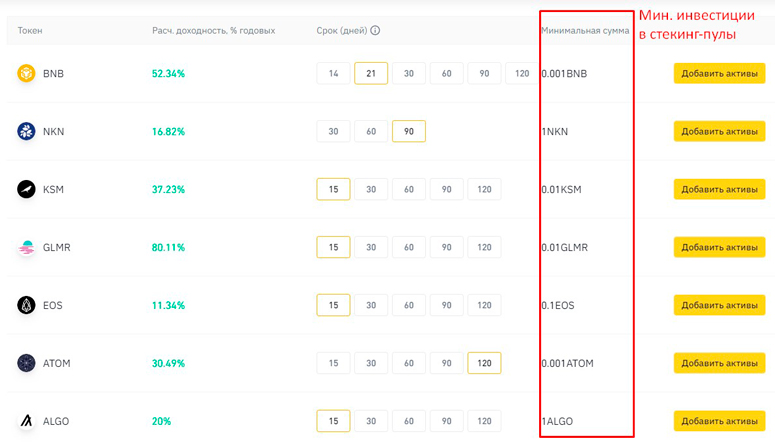
Mezgli tiek atalgoti par bloku iekļaušanu digitālajos tīklos. Tajā pašā laikā katram virtuālo ķēžu saišu apstiprinājumam tiek izvēlēts noteikts skaits validatoru. Piemēram, BNB viedās ķēdes (BSC) tīklam nepieciešams tikai 21 mezgls. Validatoru izvēlas, pamatojoties uz 3 parametriem:
5020 $
bonuss jauniem lietotājiem!
ByBit nodrošina ērtus un drošus kriptovalūtu tirdzniecības nosacījumus, piedāvā zemas komisijas maksas, augstu likviditātes līmeni un modernus tirgus analīzes rīkus. Tā atbalsta tūlītēju tirdzniecību un tirdzniecību ar sviras finansējumu, kā arī palīdz iesācējiem un profesionāliem tirgotājiem ar intuitīvu saskarni un pamācībām.
Iegūstiet 100 $ bonusu
jauniem lietotājiem!
Lielākā kriptovalūtu birža, kurā varat ātri un droši sākt savu ceļojumu kriptovalūtu pasaulē. Platforma piedāvā simtiem populāru aktīvu, zemas komisijas maksas un progresīvus rīkus tirdzniecībai un investīcijām. Viegla reģistrācija, liels darījumu ātrums un uzticama līdzekļu aizsardzība padara Binance par lielisku izvēli jebkura līmeņa tirgotājiem!
- Ieguldījuma vecums (kopējais ieguldījuma iesaldēšanas laiks).
- Mezgla stāvoklis (interneta ātrums).
- Ieguldījuma vērtība (monētu skaits).
Proof-of-Stake ieguvei nepieciešams minimāls enerģijas patēriņš. Validatora darbībai ir nepieciešams nedaudz enerģijas.
Parasti blokķēdes veidotāji savās tīmekļa vietnēs norāda iekārtu specifikācijas. Šeit ir piemērs minimālajām prasībām Eth2 ētera steikošanas aprīkojumam:
- Operētājsistēma - jebkura 64 bitu operētājsistēma.
- Datora centrālais procesors - AMD FX-8110 vai Intel Core i5-7600.
- RAM - 4 GB.
- Brīva vieta - 20 GB.
- Interneta ātrums - 10 Mb/s.
Turklāt, veicot kriptominingu ar PoS, ir grūti veikt 51% uzbrukumu. Lai to veiktu, ir nepieciešams bloķēt 51% jau iesaldēto monētu - parasti miljardiem dolāru. Tas ir ne tikai ļoti dārgi, bet arī neatmaksā uzbrukuma rezultātu.
Kad uzbrucējs sāk pirkt tik daudz žetonu, to cena pieaug, eksponenciāli palielinot uzbrukuma izmaksas.
Rentabilitāte
Likmju likme bieži vien dod nelielu peļņu gadā. Rentabilitātes piemēri, uzkrājot dažādus digitālos aktīvus maka kontā 12 mēnešu periodā.
| Kriptovalūta | Biļetīte | Blockchain | Vidējā rentabilitāte 12 mēnešu laikā (2022. gada 5. jūlijā) |
|---|---|---|---|
Salīdzinājums ar PoW
Darba pierādījuma konsensa algoritms ļoti atšķiras no "pierādījuma uztveršanas" mehānisma. PoW un PoS salīdzinājums.
| Parametrs | Uzņemšanas apliecinājums | Darba apliecinājums |
|---|---|---|
| Pamatprasība kriptovalūtas ieguvei | Daudzu digitālo monētu pieejamība | Iekārtu ar augstu hash rate izmantošanu |
| Ko investori dara ar iegūtajām monētām | Bieži vien tiek uzkrāti ieguldījumiem kalnrūpniecībā ar pierādījumu par iegūšanu. | Parasti pārdod, lai samaksātu par elektroenerģiju |
| Kas saņem atlīdzību no kriptovalūtu tīkliem | Izvēlētie validatori, pēc nejaušības principa sadalot atlīdzības. | Tikai kalnračiem, kas paraksta un iekļauj blokus digitālajos tīklos. |
| Elektroenerģijas patēriņš | Zema | Ļoti augsts |
Kas ir Ethereum PoS ieguve
Tas attiecas uz ETH monētu ieguvi Etherium 2.0 blokķēdē. Šajā blokķēdē tiek izmantots PoS konsensa algoritms. Šā iemesla dēļ Ethereum 2.0 kalnrūpniecība tiek veikta, izmantojot steikošanas metodi. Lai to izdarītu, ētera turētājiem ir jābloķē monētas Ethereum 2.0 viedajā līgumā un jāsāk darboties mezgliem.
Kad validators ir iestatīts un aktivizēts, sākas darījumu un bloku verifikācijas process un tiek izmaksātas atlīdzības.
Pieejamā kriptovalūta ieguvei
2022. gada 5. jūlijā populārākās un ienesīgākās monētas PoS ieguvei ir:
- Grafiks - līdz 128.15%. Decentralizēta protokola kriptovalūtas žetons. Izstrādātāji to izmanto, lai izveidotu pieprasījumus Ethereum blokķēdē.
- PancakeSwap - līdz 87.41%. Decentralizētās biržas PancakeSwap žetons. Protokols darbojas BSC tīklā.
- Axie Infinity - līdz 72,00%. Žetons no tāda paša nosaukuma platformas GameFi projekta veidotājiem. Spēle darbojas Ronin tīklā - Ethereum sānu ķēdē.
- DeFiChain - līdz 47.52%. Arī tāda paša nosaukuma platformas kriptovalūta. Tās izstrādātāji veido protokolu, lai spēcīgi paplašinātu DeFi digitālo sektoru.
- EOS - līdz 34.00%. Kriptovalūtas projekta Block.one monēta. Tās radītāji savā platformā palaida savu blokķēdi (Ethereum konkurentu), lai klientiem nodrošinātu lielu joslas platumu - iespēju ātri veikt darījumus.
- Osmosis - līdz 29,93%. Tā paša nosaukuma kriptovalūtas platformas žetons. Platformas tirdzniecības sistēmas galvenie elementi ir balstīti uz Tokijas biržas izstrādājumiem.
- Noslēpums - līdz 24,97%. Slepenā tīkla projekta monēta. Tās izstrādātāji izveido konfidenciālu blokķēdi ar iespēju izmantot dažādu uzņēmumu viedos līgumus.
- THORchain - līdz 19.31%. Kriptovalūtas projekta THORchain monēta. Tās blokķēde ir balstīta uz decentralizācijas un anonimitātes principiem. Tīkls ļauj lietotājiem ātri pārskaitīt daudzas populāras digitālās monētas starp ķēdēm.
- Kusama - līdz 15.26%. Tā paša nosaukuma kriptovalūtas monēta blokķēdē. Tīkls ir paralēla Polkadot blokķēde, kas ļauj izstrādātājiem testēt jaunus protokolus un citus risinājumus pirms oficiālās palaišanas.
- Cronos monēta - līdz 14,75%. Cronos kriptovalūtas sistēmas žetons. Projekts nodarbojas ar decentralizētu protokolu izplatīšanu un savas blokķēdes izveidi.
Kā sākt PoS ieguvi
Kriptovalūtas ieguves sākšana ar validatora izveides metodi tiek veikta, izmantojot īpašu programmatūru. Darbības algoritms uz Efirium 2.0 blokķēdes piemēra izskatās šādi:
- Atveriet oficiālo Ethereum Launchpad.
- Noklikšķiniet uz "Kļūt par validatoru".
- Izlasiet visus noteikumus, nosacījumus un noteikumus.
- Izvēlieties 1 no 4 piedāvātajiem izpildītāja klientiem (Eth1) un instalējiet to (norādījumi ir lapā).
- Noklikšķiniet uz "Turpināt".
- Izvēlieties 1 no 4 konsensa programmām un lejupielādējiet to (rokasgrāmatas ir pieejamas Ethereum tīmekļa vietnē).
- Noklikšķiniet uz "Turpināt".
- Norādiet darbināmo mezglu skaitu.
- Izvēlieties PoS ieguvei paredzētās aparatūras operētājsistēmu.
- Izveidojiet kriptovalūtas atslēgu pāri.
- Lejupielādējiet validatora atslēgas failu.
- Izveidojiet maku un papildiniet etherium adreses atlikumu.
- Lejupielādēt deposit_data.json.
- Apstipriniet kriptovalūtas krātuves mnemonikas un saglabājiet atslēgas.
- Augšupielādējiet deposit_data.json uz PoS kalnrūpniecības pārvaldības vietni un savienojiet maku ar pakalpojumu.
- Bloķēt ēterus viedajā līgumā.
Kad PoS algoritms ir izpildīts, Ethereum ieguve sāksies automātiski. Pašpietiekama ieguve izmantos iekārtas skaitļošanas jaudu.
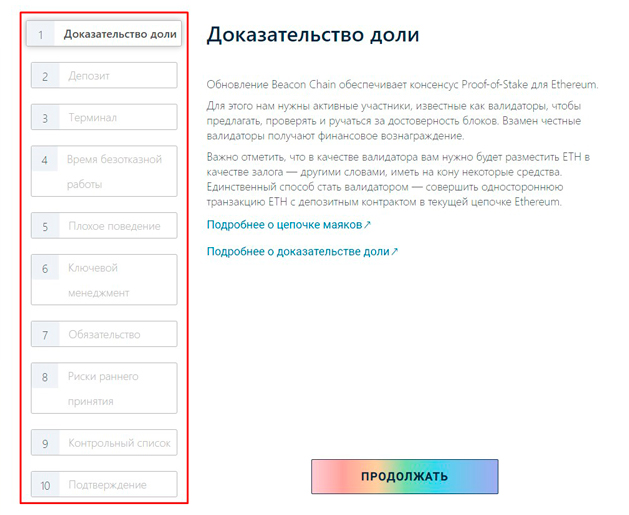
Ir vieglāk sākt PoS ieguvi, izmantojot steaking pool. Algoritms, kā pieslēgties uzticamam validatoram, piemēram, Binance Staking pakalpojumam, ir šāds:
- Dodieties uz kriptovalūtas sistēmas Binance tīmekļa vietni.
- Atveriet Earn rīku sarakstu.
- Dodieties uz sadaļu Binance Earn.
- Sarakstā "Staking" izvēlieties "ETH Staking 2.0".
- Noklikšķiniet uz "Start Steaking".
- Norādiet mērcēšanas laiku.
- Atzīmējiet izvēles rūtiņu "Esmu iepazinies un piekrītu Binance Staking Service Agreement" un noklikšķiniet uz "Apstiprināt".
Kad algoritms ir pabeigts, noteiktais kriptovalūtas monētu skaits tiks ieguldīts likmju fondā. ETH ieguve sāksies automātiski, neizmantojot aparatūras jaudu.
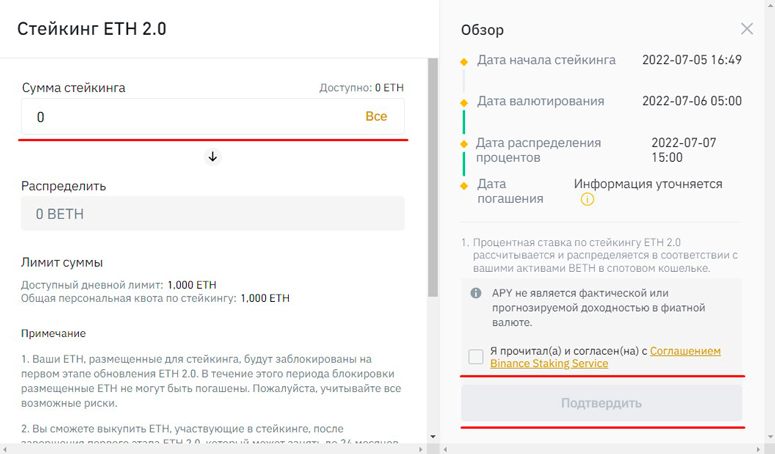
Priekšrocības un trūkumi
PoS kalnrūpniecības plusi un mīnusi.
| Priekšrocības | Trūkumi |
|---|---|
| Augsta vides drošība. Validācijai nav nepieciešams liels hash ātrums, tāpēc procesam nav nepieciešams liels elektroenerģijas patēriņš. | Samazināts kriptovalūtu apgrozījums. Ieguldītāji ir ieinteresēti noguldīt monētas, nevis tirgoties digitālo aktīvu tirgū. |
| Minimāls risks zaudēt ieguldījumu. Parasti kriptovalūtu var izņemt no likmes un pārdot jebkurā laikā. | Decentralizācijas draudu klātbūtne. Lieli blokķēdes mezgli savāc daudz monētu vienās rokās. |
| Kriptovalūtu ieguves apliecinājuma (Proof-of-Stake) pieejamība bez specializētām zināšanām. PoS kalnrūpniecība, izmantojot pūlus, ir pieejama daudziem lietotājiem. | Zema peļņa. Daudzu populāru kriptovalūtu zagšanas ienesīgums reti pārsniedz 20%. |
| Ģeogrāfiskās piesaistes trūkums. Mezglu validatorus var palaist pat klēpjdatoros. | Augsts ienākšanas slieksnis. Lai uzsāktu darbību savā mezglā, ir nepieciešami lieli ieguldījumi. Tomēr šo problēmu atrisina steķēšanas pūli. |
| Augsta tīklu tehniskā drošība ar "Proof-of-Stake" algoritmu | |
| Liela kriptovalūtu platformu izvēle digitālo aktīvu PoS ieguvei |
Secinājumi
PoS kalnrūpniecībā ir kriptovalūtas konsensa algoritms. Tas nosaka blokķēžu darbības metodes un atlīdzības izmaksas nosacījumus validatoriem - tīklu ar Proof-of-Stake mezgliem. Kriptovalūtu ieguvi saskaņā ar PoS sauc par likmju likšanu. Tā ietver digitālo aktīvu bloķēšanu makos vai tīklu viedajos līgumos.
2022. gada 5. jūlijā ir pieejamas 2 PoS ieguves metodes:
- Vienreizēja kraušana. Šai metodei ir nepieciešams palaist savu validatora mezglu.
- Kopīga steikošana. Šai metodei nepieciešama dalība baseinā.
Biežāk uzdotie jautājumi
❓ Vai PoW vai PoS ir labāka?
Proof-of-Stake algoritms ir daudzsološāks nekā Proof-of-Work, jo kriptovalūtu tīklus ir iespējams mērogot. Tajā pašā laikā aplūkojamais konsensa mehānisms tiek uzskatīts par drošāku.
❕ Vai solo PoS mining vai pool steaking labāk?
Rentabilitātes ziņā labāk izvēlēties pirmo iespēju. Otrā metode ir piemērota investoriem ar nelieliem ieguldījumiem.
✅ Kuras kriptovalūtas būtu jāizraktu?
Ieteicams staipīt tās monētas, kuru cenas nākotnē var pieaugt. Tas palielinās PoS ieguves peļņu.
⭐ Kādēļ kļuva populārs apliecinājums par iegūšanu?
Blokķēdēm ar šo algoritmu ir augsts mērogošanas potenciāls. Turklāt PoS ieguvei nav nepieciešams daudz elektroenerģijas, un tā ir salīdzinoši vienkārša.
💰 Labākās kriptovalūtas pēc rentabilitātes?
Pieci ienesīgākie digitālie aktīvi ir GRT, CAKE, AXS, DFI un EOS.
Vai tekstā ir kļūda? Izceliet to ar peli un nospiediet Ctrl + Ievadiet
Autors: Saifedean Ammous, kriptovalūtu ekonomikas eksperts.


